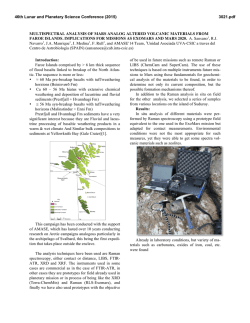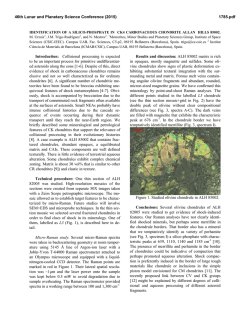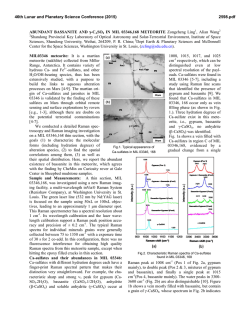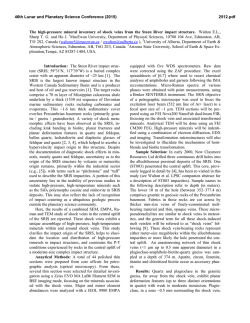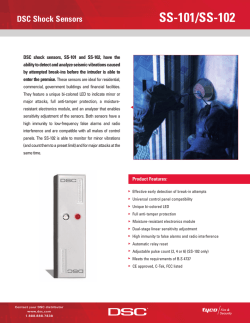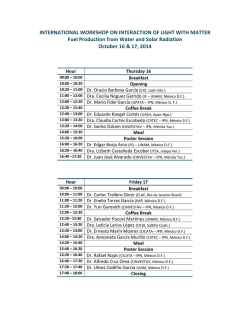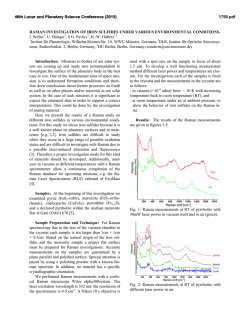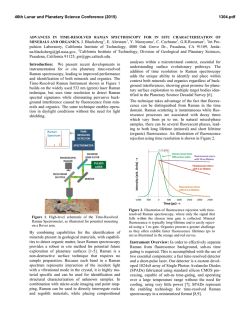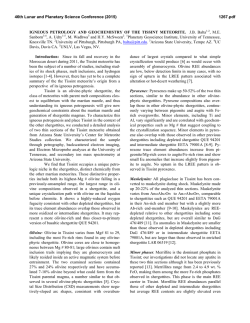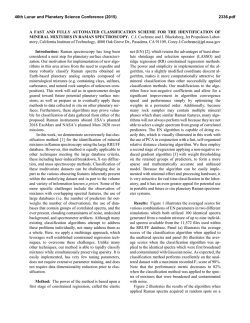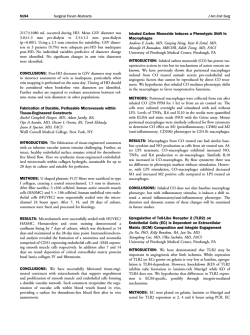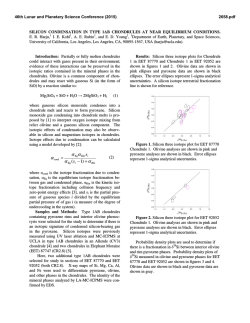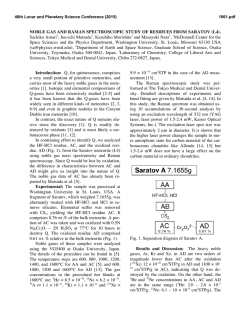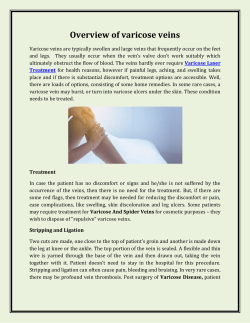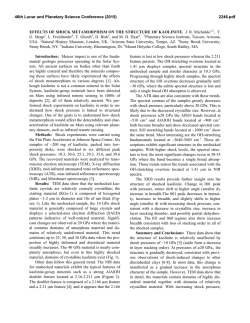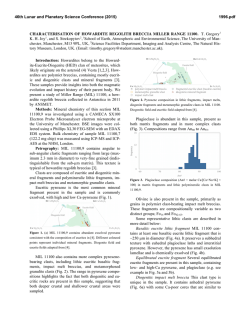
The Degree of Shock Metamorphism in Villalbeto de la Peña
46th Lunar and Planetary Science Conference (2015) 1477.pdf THE DEGREE OF SHOCK METAMORPHISM IN VILLALBETO DE LA PEÑA POLYMICT CHONDRITE BRECCIA INFERRED FROM RAMAN SPECTROSCOPY. E. Olvera-Valencia1, J. M. TrigoRodríguez2, C.E. Moyano-Cambero2, K. Cervantes-de la Cruz3, A. Bischoff4, G. Cordero-Tercero5, and N. Mestres6. 1 Facultad de Ciencias, Universidad Nacional Autónoma de México, Circuito Exterior CU, México DF, 04510, México, [email protected], 2Meteorites, Minor Bodies and Planetary Science Group, Institute of Space Sciences (CSIC-IEEC), Campus UAB, Fac. Sciences, C5-p2, 08193 Bellaterra (Barcelona), Spain, [email protected], 3 Instituto de Ciencias Nucleares, Universidad Nacional Autónoma de México, Circuito Interior S/N, C.U. A.P. 70543, México, DF 04530, México, [email protected], 4Institut für Planetologie, Wilhelm-KlemmStr. 10, 48149 Münster, Germany, [email protected], 5Depto. Ciencias Espaciales, Instituto de Geofísica, Universidad Nacional Autónoma de México, Ciudad Universitaria, Delegación Coyoacán, 04510 México, D.F., México, [email protected]. 6Institut Ciència de Materials de Barcelona (ICMAB/CSIC), Campus UAB, 08193 Bellaterra (Barcelona), Spain. Introduction: It is important to study the degree of shock metamorphism in meteorite minerals to estimate the impact energy and to understand the role of shockinduced metamorphism in the processing of the original material. Unweathered meteorites quickly recovered from meteorite falls are particularly valuable. The Villalbeto de la Peña (hereafter VP) meteorite was initially classified by Llorca et al. [1] as an L6 chondrite with a degree of shock metamorphism S4 and later reclassified as a polymict breccia by Bischoff et al. [2]. Casual records of the bolide had the added value of allowing the determination of VP heliocentric orbit and the identification of the dynamic mechanism that delivered this meter-sized rock from the main asteroid belt [3]. Several impacts affected the history of this rock before being delivered to Earth vicinity [1-3]. In this paper we study further evidence of shock in VP, and we report the first identification of ringwoodite and majorite within the impact veins of Villalbeto de la Peña meteorite using Raman spectroscopy. Method: A thin section of VP meteorite available at CSIC-IEEC was studied. A high-resolution mosaic of the section was created from separate 50X images taken with a Zeiss Scope petrographic microscope. We noticed in transmitted light the presence of abundant isotropic minerals in a shock vein that were probably colorless ringwoodites and majorites. To test this hypothesis several Raman spectra of minerals in the selected shock vein were recorded in backscatter geometry at room temperature, using the 514.5 nm line of an ion-argon laser with a spectrometer Jobin-Yvon T-64 000 Raman connected to an Olympus microscope, equipped with a CCD detector. This device has high lateral spatial resolution of about ~1 μm. The CrystalSleuth software was used to remove the background from our spectra and compare them to the ones found in [4]. Results and discussion: In the VP chondrite evidence of shock metamorphism was found in form of melt pockets and shock veins [1,2,5]. A previous study also described two different regions of feldspathic composition in VP [6]: maskelynite and Na-rich plagioclase. With the aim to identify shock-induced minerals we studied a thick melt vein. This dark-colored vein has a maximum width of approximately 3.5 mm. Fig. 1 shows the spatial distribution of the point-and-shoot Raman analyses of different minerals studied so far. Figure 1. Spatial distribution of minerals in a VP shock vein: b) ringwoodite, c) low-Ca pyroxene and d) majorite. Figure 2a shows the Raman spectrum representative of olivine. It was taken clearly outside the melt vein, and its characteristic bands are at 820 and 851 cm-1. Highly deformed crystals with olivine-like composition were found within the melt vein. Their Raman analysis showed characteristic bands located at 799 and 842 cm1 , typical for ringwoodite (Figure 2b). Also, some lowCa pyroxene Raman spectra were obtained inside the melt vein (Figure 2c). The Raman peaks were located at 337, 661, 683, and 1009 cm-1. However, in the spectra of other crystals, the peaks were located at 596 and 927 cm-1 and, thus, are characteristic for majorite (Figure 2d). The Raman peaks at 799 and 842 cm-1 are characteristic for ringwoodite, a high-pressure polymorph of olivine; while the peaks at 596 and 927 cm-1 corre- 46th Lunar and Planetary Science Conference (2015) 1477.pdf spond to majorite, the low-Ca pyroxene high-pressure polymorph [4]. In view of these results, the mineral grains surrounding the VP impact vein are composed mainly by olivine and low-Ca pyroxene; while, ringwoodite and majorite were frequently identified inside the vein. This indicates that minerals within the vein were totally or partially transformed to high pressure phases of olivine and low-Ca pyroxene. The presence of minerals like ringwoodite, majorite and maskelynite [3-5] indicates a higher impact degree than S4. Conclusions: Because of the presence of ringwoodite and majorite in a shock vein the degree of shock metamorphism of Villalbeto de la Peña has to be discussed in more detail. Huge parts of VP do not contain thick shock veins and a S4 classification is fully justified. However, in restricted areas like inside the studied shock vein, phases occur that indicate a shock pressure of S6. Stöffler et al. [5] also stated these S6 parts would be restricted to local regions in or near melt zones. In summary, the bulk rock of the Villalbeto de la Peña chondrite breccia has been shocked to an equilibrium shock stage of S4, but disequilibrium processes led to a S6 shock stage in restricted areas. Acknowledgements: We acknowledge the financial support provided by the Dirección General de Cooperación e Internacionalización (DGECI), the Faculty of Sciences of the National Autonomous University of Mexico (UNAM), and Dr. Guadalupe CorderoTercero, for allowing a short stay at CSIC-IEEC of first author. Spanish research has been funded by the MEC (research project AYA2011-26522). References: [1] Llorca J. et al. (2005) Meteoritics & Planet. Sci., 40, 795. [2] Bischoff A. et al. (2013). Meteoritics & Planet. Sci., 48, 628 [3] TrigoRodríguez J.M. et al. (2006) Meteoritics & Planet. Sci., 41, 505. [4] Ohtani E. et al. (2006) Earth & Planet. Sci. Lett., 227, 505-514. [5] Stöffler D. et al. (1991) Geochim. Cosmochim. Acta, 55, 3845. [6] GarciaGuinea. et al. (2009) Conference on Micro-Raman Spectroscopy and Luminescence Studies in the Earth and Planetary Sciences, Contribution Nr. 1473, p.36. [7] Trigo-Rodríguez J. M. et al. (2013) 76th Ann. Meteoritical Soc. Meeting. Meteoritics & Planet. Sci. Suppl., abstract #5181. d) Majorite 927 596 Intensity (A.U.) c) Low-Ca pyroxene 661 337 683 1009 b) Ringwoodite 799 820 a) Olivine 200 842 851 400 600 800 1000 1200 1400 -1 Wavenumber (cm ) Figure 2. Characteristic Raman spectra of a) olivine, b) ringwoodite, c) low-Ca pyroxene, and d) majorite.
© Copyright 2025
